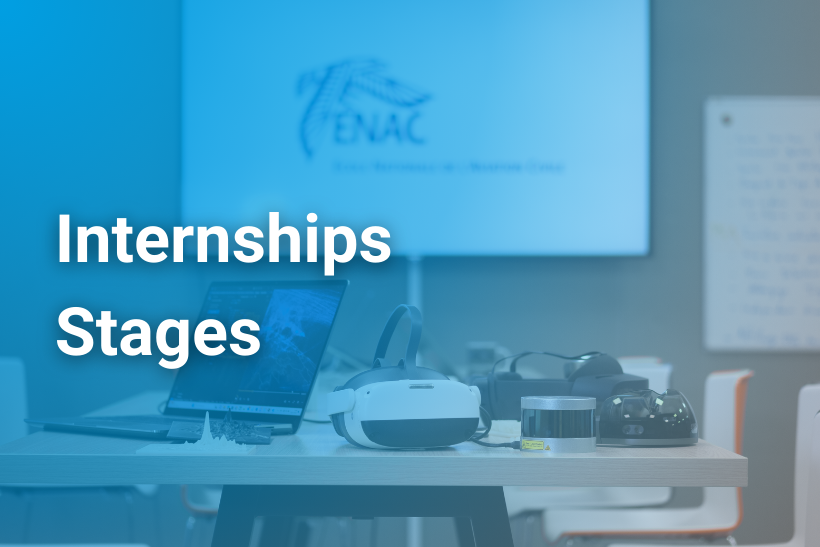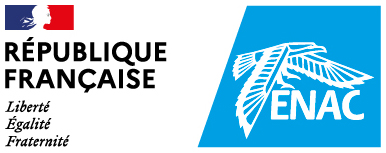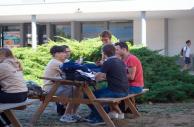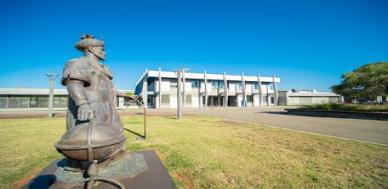
Throughout the year, ENAC offers internships for students in various fields.
For unsolicited applications, please write to recrutement@enac.fr
Current list of courses on offer :
M2 Internship - Analysis of invention in lineages of interaction techniques F/H
Context:
Much of the research in human-computer interaction focuses on the invention of new interaction techniques, as evidenced by publications in UIST or CHI conferences or reference books, such as (Myers 2024). An interaction technique is what makes it possible, by combining input and output modalities (2D graphics, gestures, speech...), to perform elementary interaction tasks such as selection, data input, triggering, scrolling or specifying arguments and properties. For example, scrolling in a video can be performed by direct manipulation, not by a scroll bar, but by inputting and moving a moving object in the video (Dragicevic et al 2008). The simultaneous specification of arguments in a drawing tool can be performed by a single gesture traversing several palettes (CrossY, Apitz et al 2004). Selecting a target from a set of bubbles of different sizes can be achieved more efficiently by dynamically resizing the size of the selection cursor (Bubble Cursor, Grossman et al 2005). Selection within an area can be achieved bi-manually by sizing and selecting within the area (WritLarge, Xia et al 2017). As a final, well-known example, geometric shapes can be entered using a combination of voice commands and pointing gestures (Bolt 1980).
Objectives of the internship:
The aim of this internship is to describe examples of such technical patterns, through a review of the scientific literature and an analysis of two or three case studies. The description of the patterns involved in the evolution of interaction techniques is present to some extent in the scientific literature on HMI, notably in the “state of the art” sections which serve to situate the published interaction technique in relation to lineages, as well as in the history of interaction techniques (Myers 2024). An initial study of lineages could thus be inspired by an analysis of these sections with this specific objective in mind. Technical schemas are also present in courses, in the schemas of engineers and researchers. INRIA's Museum of Interaction (Mackay 2015) is a census that proposes an initial classification of these techniques, as does the cladistic classification of tangible interactive objects proposed by (Fleck et al 2018). The instrumental interaction model (Beaudouin-Lafon 2000), which makes it possible to specify for an instrument its degrees of indirection, integration and compatibility, provides a formalization of what concretization would be for an interactor. It's a static measure, but we could imagine using it to measure the degree of concretization of an object evolving in a technical lineage. This model is an example of a schema, but there would probably be others whose genesis would demonstrate concreteness, such as liaison (Magnaudet et al 2018), a schema that unifies several forms of interaction. Finally, HCI research into innovation in interaction techniques includes what are known as “design spaces” (e.g. Card and Mackinlay 1990) or “characterization space” (Baglioni et al 2009). The aim of these “design spaces” is to characterize the technical and functional properties of interaction techniques and the dimensions of problems.
Work:
- Study of articles on interaction techniques (related work)
- Study of design spaces (characterization spaces)
- Identification of exaptation cases
- Selection of a case study
- Code analysis on a line
Candidate profile:
- Initial knowledge of HCI
- Interest in research
- Sufficient programming skills
- Some interest in the philosophy of technology
To apply: Send a CV and motivation letter by email to Catherine.LETONDAL@enac.fr;
Location : ENAC, 7 avenue Edouard Belin à Toulouse (campus universitaire Rangueil)
Design of optimal coupling between temporal blanker and ADC/AGC block for an airborne DFMC receiver
Context:
In the context of civil aviation, it is important to characterize the Radio Frequency Interference (RFI) relevant to the airborne GNSS receivers processing signals in the L1/E1 and L5/E5a bands to guarantee Safety-of-Life (SoL) service. Focusing on GNSS L5/E5a band, the RFI environment is dominated by pulsed interferences such as DME/TACAN and JTIDS/MIDS signals. Airborne Dual-Frequency Multi-Constellation (DFMC) GNSS receivers must implement a temporal blanker to mitigate these types of pulsed signals. The temporal blanker role is setting to zero received signal samples having its instantaneous power envelope higher than a certain threshold (interference detection/mitigation).
Objectives:
The main objective of this internship is twofold, first to analyze potential temporal blanker implementations and coupling configurations with the ADC/AGC and second, to identify the most performing implementation/promising solution in terms of 𝐶/𝑁0,𝑒𝑓𝑓 degradation. If the time allows it, the identified solution will be implemented and introduced to the GNSS L5/E5a receiver in presence of pulsed RFI simulator of the SIGNAV research group.
Work plan:
The following tasks are planned for the internship:
- State-of-the-art on ADC/AGC, temporal blanker and 𝐶/𝑁0,𝑒𝑓𝑓 mathematical models
- Analysis and testing of temporal blanker implementations
- Analysis and testing of ADC/AGC implementations
- Analysis, mathematical design and testing of coupled temporal blanker and ADC/AGC blocks
- Mathematical modelling of 𝐶/𝑁0,𝑒𝑓𝑓 degradation for the identified temporal blanker/ADC/AGC coupling configurations and selection of the most promising one.
- (Optional) Implementation of the overall scheme on the GNSS L5/E5a receiver in presence of pulsed RFI simulator of the SIGNAV research group
- Report redaction
- Defense preparation
Candidate’s profile:
Master student in electrical/telecommunications/electronic engineering with background in signal processing. Knowledge in GNSS will be appreciated.
Location : ENAC, 7, avenue Edouard Belin BP 31055 Toulouse Cedex 4, building F.
Salary : A financial compensation of 650 €/month will be provided.
Duration : 6 Months (flexible)
Starting date : March 2025 (flexible)
Investigation of factor graph optimization for GNSS
Context:
Factor graph optimization has been successfully used in order to compute GNSS solutions with accuracy performances exceeding those of more traditional approaches such as weighted least squares estimation or extended Kalman filter. Notably, it gained the first place in 2 editions of an open challenge organized by Google called the Google Smartphone Decimeter Challenge.
Objectives:
The goal of this internship is to implement in python a factor graph optimization algorithm on real GNSS observations. To implement the graph, realistic state and observation models from the literature will be considered. To validate the implementation of the algorithm, the comparison of a FGO solution will be compared to an existing Kalman Filter-based solution, to check that they are equivalent when considering only the last set of GNSS observations.
Work plan:
The proposed work plan follows the following steps :
- State of the art on Factor Graph Optimization and its use for GNSS
- Contribution to software code performing FGO on simulated and real GNSS data
- Performance analysis of FGO and comparison with Kalman Filter performances
Depending on the progress, the algorithm will be tested against large GNSS datasets, such as the Google Smartphone Decimeter Challenge. Interactions with a PhD student from ENAC and experts from CNES may also be possible.
Candidate’s profile:
Master student in electrical/telecommunications/electronic engineering with background in estimation theory and signal processing. Knowledge in GNSS, aerospace systems or robotics will be appreciated.
Location : ENAC, 7, avenue Edouard Belin BP 31055 Toulouse Cedex 4, building F.
Salary : A financial compensation of 650 €/month will be provided.
Duration : 6 Months (flexible)
Starting date : March 1st 2025 (flexible)
Commande sans modèle pour la dynamique des qubits supraconducteurs dans le cadre de la préparation d’états quantiques F/H
Descriptif du poste
L’objectif de ce stage sera de développer une méthode de commande sans modèle (MFC) pour la préparation d'états quantiques dans la dynamique des qubits supraconducteurs, en utilisant un code de commande prédictive par modèle (MPC) existant comme point de départ.
Profil recherché :
- Fin d’études bac +5
- Master 2 recherche
Méthodes à mettre en oeuvre :
- Recherche théorique
- Recherche appliquée
Lieu de travail : ENAC, 7 avenue Edouard Belin à Toulouse (campus universitaire Rangueil)
Rémunération : gratification de 4,35 euros net/heure
Durée souhaitée : 2 mois minimum et 6 mois maximum.
Période souhaitée : printemps-été 2025
Commande optimal de robot par pilotage de la covariance F/H
Descriptif du poste
L’objectif du stage sera d’évaluer en simulation les performances d'une commande avancée reposant sur la technique de covariance steering (CS) robuste, développée dans un article de recherche récent. Cette méthode, appelée Distributionally Robust Iterative Risk Allocation (DR-IRA), propose une extension de la commande CS pour les systèmes linéaires stochastiques discrets, en utilisant des contraintes de risque robustes vis-à-vis des incertitudes de distributions d’état.
Profil recherché :
- Fin d’études bac +5
- Master 2 recherche
Ce travail inclura
- La modélisation des incertitudes
- La mise en oeuvre de simulations basées sur des trajectoires optimisées
- Une analyse comparative des résultats obtenus.
Méthodes à mettre en oeuvre :
- Recherche théorique
- Recherche appliquée
Lieu de travail : ENAC, 7 avenue Edouard Belin à Toulouse (campus universitaire Rangueil)
Rémunération : gratification de 4,35 euros net/heure
Durée souhaitée : 2 mois minimum et 6 mois maximum.
Période souhaitée : printemps-été 2025
Gestion et valorisation des mémoires de fin d’études produits par les élèves de l’ENAC F/H
Descriptif du poste
Sous la responsabilité de la personne en charge de la gestion des mémoires, le/la stagiaire participera à la mise en oeuvre du nouveau circuit de dépôt et de traitement des mémoires produits par les élèves, qui prévoit, à partir de la rentrée 2024, un auto-dépôt sur un portail dédié créé avec le logiciel OMEKA S.
Profil recherché :
Diplôme préparé :
- Inscription en licence ou ayant validé celle-ci en vue d'un master
- Inscription en Master 1 ou 2 métiers du Livre et de l’édition ou métiers des Bibliothèques
Savoir-faire :
- Maîtrise des outils bureautiques
- Niveau d’anglais satisfaisant (niveau B1)
- Aisance informatique
Savoir-être :
- Aptitude à travailler en équipe et qualités relationnelles
- Polyvalence
- Sens de l’organisation et rigueur
- Capacité de prise d’initiative et d’anticipation
- Capacité d’adaptation.
Lieu de travail : Bibliothèque de l’ENAC, 7 avenue Edouard Belin à Toulouse (campus universitaire Rangueil)
Horaires : 35h/semaine du lundi au vendredi Rémunération : gratification de 4,35 euros net/heure
Durée souhaitée : 4 mois minimum. Le stage peut débuter dès le mois d’octobre 2024
Pour consulter nos offres d'emploi au sein de l'ENAC, consultez ce lien : Travailler à l'ENAC









